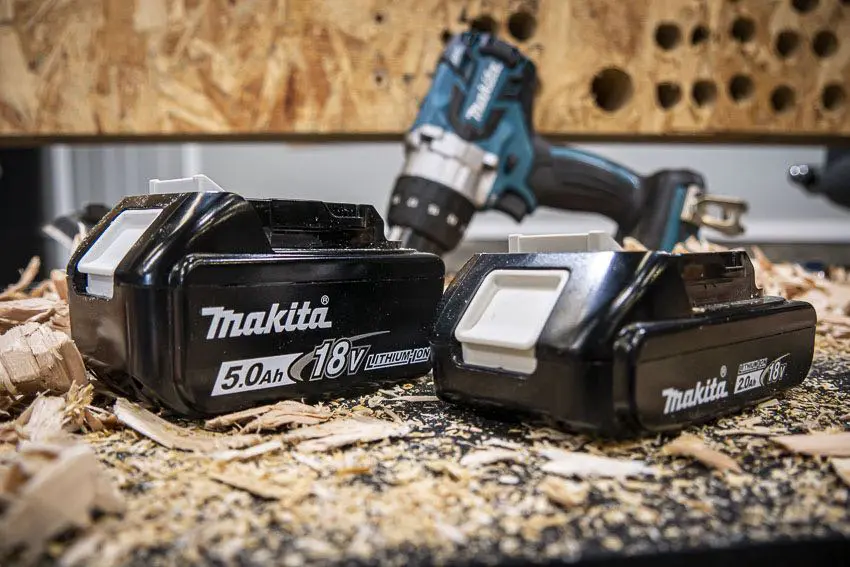Battery Amp Hours Really Do Affect How Much Power Your Power Tool Delivers
In our Craftsman vs Ryobi hammer drill comparison, several people pointed out that we were using different batteries: a 2.0Ah for the Craftsman and a 4.0Ah for the Ryobi. Because most people buy these tools as kits, we tested the kitted batteries. However, most tool enthusiasts know that battery amp hours affect power. But by how much?
First of all, for those of you who commented, thank you for the maturity you showed in the tone of your comments. It’s really refreshing to us as fellow members of the human race to be treated that way!
To address this apparent controversy, we grabbed Makita 18V LXT 2.0Ah and 5.0Ah batteries. We wanted to see just how much of a difference in power the bigger 5Ah battery pack makes. We selected the Makita XPH07 drill driver to help us with our testing.
Voltage vs Amp Hours 101
18V and 20V Max batteries both use 5 cells per row to reach 18 nominal volts. Each cell contributes 3.6 volts (4.0 volts Max) and the series connection between them brings it to a total of 18 volts (5 x 3.6).
The Makita 2.0Ah battery uses just a single row of 5 cells. The 5.0Ah pack uses two rows of battery cells attached to each other with a parallel connection. That keeps the voltage at 18 but doubles the amp hours to 5.0.
But there’s more to the story.
You see, the 5.0Ah pack actually has more than double the amp hours of the 2.0Ah battery. That’s because they’re using different cells. They’re both 18650 sizes, but with different energy densities. So in addition to having double the cells, the 5.0Ah battery also has a higher energy density in each one.
In general, higher amp hours mean more runtime and higher voltage means more power.
Read more about the relationship between voltage and amp-hours.
Makita 18V LXT 2.0Ah vs 5.0Ah Battery Comparison
2.0Ah Pack
- Model: BL1820B
- Lithium-Ion Cells: 5
- Weight: 0.8 pounds
- Charge Time: 25 minutes
5.0Ah Pack
- Model: BL1850B
- Lithium-Ion Cells: 10
- Weight: 1.4 pounds
- Charge Time: 45 minutes
Do Battery Amp Hours Affect Power?
High-Speed Test: 1-Inch High-Speed Auger Bit
We like using stacked OSB subfloor as a testing material because of its consistency. Drilling through 5 layers isn’t exactly a real-world application, but it evens out issues that come from hitting knots or other inconsistencies in lumber. We started testing how much battery amp hours affect power by drilling with 1-inch Bosch Daredevil High-Speed Auger Bits.

With these super-smooth bits, the 5.0Ah battery had a slight advantage, 4.33 seconds to 4.48 seconds.
5.0Ah Power Boost: 3.35% Faster Drilling
High-Speed Test: 1-Inch Spade Bit
We stuck with the same material while switching to 1-inch Bosch Daredevil Spade Bits for the next test. These don’t drill as smoothly and they require a bit more power than the auger bits. Even so, we could still easily drill at high speed.

The small gap we saw between the two batteries in the first test widened with spade bits, 3.59 seconds to 4.00 seconds.
5.0Ah Power Boost: 10.25% Faster Drilling
Low-Speed Test: 1 1/2-Inch Self-Feed Bit
When we moved into low-speed testing, we also switched over to a pair of untreated 2 x 4s for our material. We started with a 1 1/2-inch Milwaukee Switchblade Self-Feed Bit.
As the amount of power required continued to increase with the new bit, the gap continued to widen between the two batteries’ drilling speeds. The 5.0Ah battery took 10.28 seconds while the 2.0Ah pack needed 12.08 seconds.
5.0Ah Power Boost: 14.90% Faster Drilling
Low-Speed Test: 2 9/16-Inch Self-Feed Bit

The last test we ran was with a 2 9/16-inch Switchblade, calling on a much greater level of power from the drill. Here again, the 5.0Ah battery showed its ability to deliver higher power to finish the task, taking 11.26 seconds compared to the 2.0Ah’s 14.60 seconds.
5.0Ah Power Boost: 25.88% Faster Drilling
Battery Amp Hours Affect Power, But Why?
It stands to reason that if both battery packs deliver 18 volts, it shouldn’t affect the power, just the runtime. A closer look at the pack design offers some insight. Power is measured in watts and you can calculate it by multiplying volts and amps.
The drill really is asking for 18V from both batteries, so that remains constant. Where the number of cells comes into play is in the amps (current). Let’s say the Makita XFD07 needs 360 watts of power to drill the next hole. At 18V, the batteries each need to deliver 20 amps of current to make it happen (18V x 20A = 360W).
Each cell in the series has to contribute the full current since it isn’t additive between series connections. The 5 cells in the 2.0Ah pack each need to deliver 20 amps. In the 5Ah battery, there are two sets of cells, and the parallel connection between them does make the current additive. So each set only asks its cells to give 10 amps each.
It’s much easier for 10 cells each working half as hard to keep the power level up. The tougher the task, the harder it is for 5 cells to maintain the same power level as 10 cells.
It’s a similar story when you test runtime. In theory, a 4.0Ah battery should give you exactly twice the runtime of a 2.0Ah battery. However, you actually get a bit more than that. We found that amp-hours affect runtime in a big way.
The Bottom Line
Now that we know how significantly battery amp hours affect power, the application side is pretty straightforward. In lighter-duty tasks, a bigger battery doesn’t have a huge advantage, so save some weight and go with the smaller pack. As you move into medium and heavy-duty applications, the difference is substantial and a higher capacity battery is the way to go.




